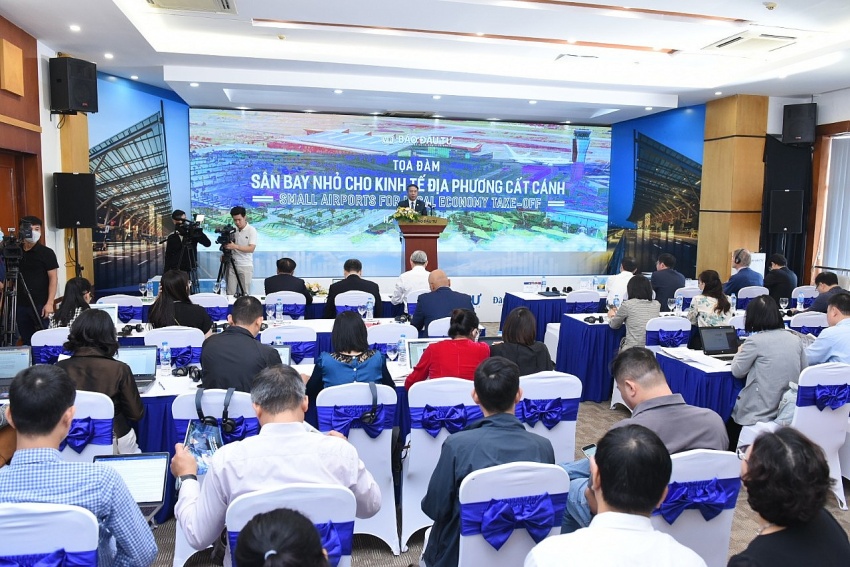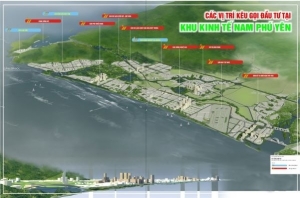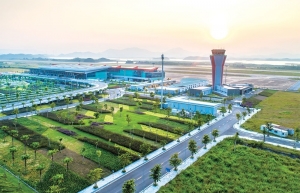Small airports set to help local economies take off
 |
| The roundtable kicks off |
The Vietnam Investment Review roundtable 'Small airports for local economy take-off' was held this morning with the participation of speakers from a variety of local and international organisations.
According to the International Air Transport Association (IATA), Vietnam ranks No.1 on the list of 25 countries with the fastest recovery in the domestic aviation market post-pandemic. Before the COVID outbreak, the country's aviation sector had been growing at a double-digit rate, averaging 15.8 per cent annually.
The IATA forecasts that by 2035, Vietnamese airlines will serve up to 136 million passengers and contribute $23 billion to GDP. However, the existing airport system, especially small airports such as Con Dao, Cat Bi, Phu Quoc, Lien Khuong, and Cam Ranh, is overloaded.
| According to the International Air Transport Association, Vietnam ranks No.1 on the list of 25 countries with the fastest recovery of the domestic aviation market post-pandemic. |
In Vietnam, airlines and airports contribute significantly to the economic growth of localities and the wider country. In 2019, the aviation industry, including passenger spending, contributed $12.5 billion to the country's GDP.
Michel Werson, chief economist at NACO – part of Royal HaskoningDHV – said, “Along with the role of transport linkage, small airports will contribute to creating many other economic values. Notably, they will create benefits for investors and generate jobs for people. The small airport is a factor to attract investment capital inflow to localities and then contribute to the state budget.”
Small airports will also wake up the tourism potential of various localities. For example, following a major expansion between 2017-2018, Phu Quoc International Airport has been an important international gateway to many iconic destinations and made significant contributions to the socioeconomic development of the 'Pearl Island.' Before the pandemic, Phu Quoc's economy was growing by an average of 27.52 per cent per year, and tourism revenue was rising by up to 43 per cent per year.
Cam Ranh International Airport is another outstanding example. In 2004, the airport only served 270,000 passengers. In 2019, the airport saw tourist arrivals grow nearly 40-fold, receiving over 10 million passengers, of which more than 3.5 million were international tourists. The government has approved an upgrade for Cam Ranh International Airport to have an annual capacity of 25 million passengers by 2030 and 36 million by 2050.
The ground-breaking ceremony of Sapa Airport in March 2022 has turned the dreams and aspirations of provincial leaders and local ethnic minorities into a reality. Once completed, the airport is expected to boost the economy and tourist development in the northern province of Lao Cai.
Confronted by ever-crowding airports, experts at the roundtable agreed that the construction of a major airport was needed to accommodate the soaring growth.
Nguyen Van Vinh, deputy director of the Vietnam Institute for Development Strategies said, “To invest effectively in the airport, it is necessary to have a combination of the state and the private sector to jointly calculate the timeline and scale of the projects. It is also needed to evaluate every aspect carefully to avoid wasting natural and power resources while simultaneously clarifying the concept of the small airport.”
“In addition, it is important to consider the transportation link plans to synchronise other transport infrastructure systems, including the road, rail, and sea link, to connect with the airport. This work will attract private investors to invest in the airport,” he said.
'Small airports for local economy take-off' was live-streamed on the website and fan page platforms of VIR publications vir.com.vn, baodautu.vn, and tinnhanhchungkhoan.vn.
 | Serious lessons to take on board for Vietnam’s airport development targets Cities and provinces in Vietnam are rushing to develop more airports to support their socioeconomic development. Juergen Weber, chairman of the European Chamber of Commerce in Vietnam’s Transportation and Logistics Sector Committee, talked to VIR’s Bich Thuy about the importance of airport development to a locality. |
 | Airport plans depend on investment Vietnam’s ambitions to transform its airport infrastructure will have to deal with various challenges in attempting to attract private investment. |
 | Ministry approves expansion of South Phu Yen EZ Phu Yen People's Committee is completing the general planning for South Phu Yen Economic Zone (EZ) after consulting the Ministry of Construction's Appraisal Council. |
 | Funding essential for domestic airport expansions Nakajima Takeo, chief representative of the Hanoi Office of the Japan Trade Promotion Organization and vice president of the Japanese Chamber of Commerce and Industry in Vietnam talked to VIR’s Minh Anh about the essential attraction of multi-investment sources in building advanced airport facilities and operations in Vietnam. |
 | PPPs driving small airport investment Vietnam wants to increase investment in domestic airports and establish better infrastructure, but capital will only increase when the institutional conditions are further improved. |
What the stars mean:
★ Poor ★ ★ Promising ★★★ Good ★★★★ Very good ★★★★★ Exceptional
Related Contents
Latest News
More News
- PM orders investment model for North–South high-speed rail (December 22, 2025 | 17:43)
- First members of Danang International Finance Centre revealed (December 22, 2025 | 17:39)
- Securing capital and efficiency for Vietnam’s 2026-2030 growth ambitions (December 17, 2025 | 10:00)
- Driving double-digit growth through green and circular transformation in Vietnam (December 17, 2025 | 09:00)
- Vietnam bucking trend in the global M&A landscape (December 16, 2025 | 14:20)
- Vietnam’s green transition demands collective financial action (December 15, 2025 | 12:00)
- VIR workshop highlights capital and policy for sustainable development (December 15, 2025 | 11:00)
- National Assembly approves pilot mechanisms to accelerate major projects in Hanoi (December 12, 2025 | 11:29)
- Vietnam eases policy approval requirements, simplifies foreign and outbound investments (December 11, 2025 | 17:53)
- Unpacking new momentum in Vietnam’s M&A market (December 10, 2025 | 09:59)

 Tag:
Tag:





















 Mobile Version
Mobile Version